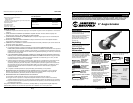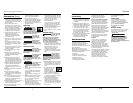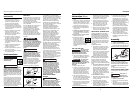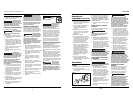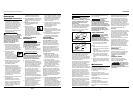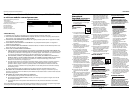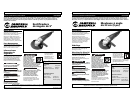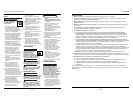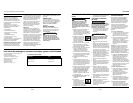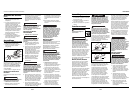
1. DESENCHUFE LA RECTIFICADORA.
Antes de volver a conectar la
herramienta, oprima y suelte el
gatillo para asegurarse de que
la herramienta esté apagada.
2. Abra el seguro de protección y
alinee las salientes con las ranuras
en la tapa de la caja de engranajes.
Ubique la protección de modo que
mire hacia atrás.
3. Empuje la protección hacia abajo
hasta que la saliente de la
protección se enganche y gire
libremente en la ranura del cubo
de la caja de engranajes.
4. Coloque la rueda en el reborde
de apoyo, centrando la rueda en
el piloto del reborde de apoyo.
5. Instale la tuerca de sujeción,
asegurándose de que la rueda
permanezca centrada en el reborde
de apoyo.
6. Oprima el botón de bloqueo del
vástago y ajuste la tuerca de
sujeción con la llave.
7. Invierta el procedimiento anterior
para quitar la rueda.
8. Gire la protección hasta la posición
de trabajo deseada.
Funcionamiento
Se deberán usar gafas de
seguridad durante el
funcionamiento.
Asegúrese de que el trabajo esté sujeto
en forma segura en una prensa de
tornillo o mordaza antes de comenzar la
operación. Si la pieza de trabajo está floja
puede girar y causar lesiones corporales.
Asegúrese de instalar la protección de
la rueda y el mango auxiliar. Tome con
firmeza el mango auxiliar y la caja del
motor.
Levante la parte trasera de la caja del
motor para que sólo la sección frontal
de la rueda abrasiva entre en contacto
con el trabajo. Aplique poca presión.
La rectificadora siempre debe estar
alejada del trabajo antes de encender
o detener el motor. La flecha en la caja
de engranajes frontal indica la dirección
en la que gira la rueda abrasiva.
!
PRECAUCION
!
ADVERTENCIA
RECTIFICADO, LIJADO,
CEPILLADO
Siempre seleccione con cuidado y use
ruedas abrasivas recomendadas para
el material a rectificar. Asegúrese de
que la velocidad mínima de
funcionamiento de las ruedas
accesorias seleccionadas no sea menor
que 11.000 RPM.
La rueda abrasiva que se proporciona
con su rectificadora es apta para
rectificar soldaduras, preparar
superficies para soldar, y rectificar
acero estructural y acero inoxidable.
El cepillo circular de alambre es
adecuado para eliminar pintura
u óxido de las superficies de metal.
El disco de paño abrasivo es adecuado
para lijar superficies planas de metal
o madera.
Nunca use la rectificadora sin la
protección. Esta herramienta fue
diseñada para ser usada ÚNICAMENTE
con la protección instalada. De intentar
usar la rectificadora sin la protección,
sepodrán desprender partículas que
sean arrojadas contra el operador,
resultando en lesiones personales
graves.
Inspeccione el cepillo circular de
alambre antes de cada uso. Nunca use
un cepillo oxidado, dañado o cuya
velocidad nominal mínima no sea de
6.000RPM. No seguir esta advertencia
puede resultar en lesiones personales
graves.
La clave para un funcionamiento
eficiente comienza controlando la
presión y el contacto con la superficie
entre la rueda abrasiva y la pieza de
trabajo. Las superficies planas se
rectifican a un ángulo agudo,
normalmente entre 5 y 15 grados.
!
ADVERTENCIA
!
PELIGRO
Para un máximo control, sostenga
la rectificadora con ambas manos,
de frente y lejos de usted, manteniendo
la rueda abrasiva fuera de la pieza de
trabajo. Encienda la rectificadora y deje
que el motor y la rueda abrasiva
alcancen la máxima velocidad. Baje
gradualmente la rectificadora hasta
que la rueda abrasiva entre en contacto
con la pieza de trabajo.
Para obtener mejores resultados
mantenga la rectificadora inclinada
a unángulo entre 5 y 15 grados
y muévala constantemente a un ritmo
parejo. Mueva la rectificadora para
adelante y atrás o arriba y abajo
en elárea de trabajo. Mantenga la
rectificadora en movimiento para no
eliminar una cantidad excesiva de
material de una misma área.
Si mantiene la rectificadora en un punto
durante mucho tiempo, cortará y hará
ranuras en la pieza. Si la rectificadora
se mantiene en un ángulo demasiado
agudo, también hará ranuras en la pieza
de trabajo debido a la concentración de
la presión en una pequeña área.
Utilice apenas la presión suficiente
para evitar que la rectificadora vibre
o rebote. Demasiada presión
disminuirá la velocidad y forzará el
motor. Normalmente, sólo el peso de
la herramienta alcanza para la mayoría
de los trabajos de rectificado.
Utilice poca presión cuando rectifique
bordes mellados o pernos flojos donde
existe la posibilidad de que la
rectificadora se enganche en un borde
de metal. Aleje la rectificadora de la
pieza antes de apagarla.
En las operaciones normales de
cepillado con alambre, el material
eliminado y las cerdas del cepillo se
dispararán (hasta 50 pies o más) con
una fuerza considerable. Existe la
posibilidad de que ocurran lesiones
graves. Para protegerse contra este
riesgo, los operadores y demás
personas en el área de trabajo deben
usar vestimenta de protección y gafas
de seguridad, o protectores para todo
el rostro sobre las gafas de seguridad
con protección lateral.
CÓMO USAR LA RUEDA
DECORTE
No utilice ruedas de corte/rectificado
de borde para las aplicaciones de
rectificado de superficies ya que estas
ruedas no están diseñadas para las
presiones laterales que sufren al
rectificar superficies. Puede resultar
enla rotura de la rueda y en lesiones.
!
ADVERTENCIA
!
ADVERTENCIA
18 Sp
5° - 15°
30°+
Figura 2 - Ángulo correcto
Figura 3 - Ángulo incorrecto
Manual de Instrucciones y Lista de Piezas
General Safety
Information (Cont’d.)
6. Keep hands away from rotating
parts.
7. Use clamps or another practical way
to secure the workpiece to a stable
platform. Never hold work in your
hand, lap, or against other parts of
your body when using this tool.
8. Make sure all nails and staples are
removed from work piece before
using this tool.
9. SANDING OF LEAD-BASED PAINT IS
NOT RECOMMENDED. Leadbased
paint should only be removed by a
professional.
10. DO NOT INSTALL WOODCARVING
BLADE on this grinder.
11. Some wood contains
preservatives which can
be toxic. Take extra care
to prevent inhalation
and skin contact when working
with these materials. Request, and
follow, any safety information
available from your material
supplier.
TOOL USE AND CARE
Do not use tool if
switch does not
turn it on or off. Any tool that cannot
be controlled with the switch is
dangerous and must be repaired.
1. This tool must NOT be modified or
used for any application other than
that for which it was designed.
Do not force the
tool. Use the
correct tool for your application. The
correct tool will do the job better and
safer at the rate for which it is
designed.
2. Maintain tools with care.
3. Check for misalignment or binding
of moving parts, breakage of parts,
and any other condition that may
affect the tool’s operation. If
damaged, have the tool serviced
before using. Many accidents are
caused by poorly maintained tools.
4. Use only accessories that are
recommended by the manufacturer
for your model. Accessories suitable
for one tool may create a risk of
injury when used on another tool.
5. Store tools out of reach of children
and other untrained persons. Tools
are dangerous in the hands of
untrained users.
6. Disconnect the plug from the
!
CAUTION
!
WARNING
power source before making any
adjustments, changing accessories,
or storing the tool. Such preventive
safety measures reduce risk of
starting the tool accidentally.
7. Always hold the grinder securely
with two hands while working and
at all times when it is running.
8. Never cover the air vents in the
motor housing with your hands
while operating the grinder.
9. Hold the tool away from your body
while it is running. Keep your hands
away from the attachments.
PRECAUTIONS: SANDING PAINT
Sanding of lead based paint is NOT
RECOMMENDED due to the difficulty
of controlling the contaminated dust.
The greatest danger of lead poisoning
is to children and pregnant women.
Since it is difficult to identify whether
or not a paint contains lead without a
chemical analysis, we recommend the
following precautions when sanding
any paint:
A. PERSONAL SAFETY
1. No children or pregnant women
should enter the work area where
the paint sanding is being done
until all clean up is completed.
2. A dust mask or respirator should be
worn by all persons entering the
work area. The filter should be
replaced daily or whenever the
wearer has difficulty breathing.
Note: Only those dust masks suitable
for working with lead paint dust and
fumes should be used. Ordinary
painting masks do not offer this
protection. See your local hardware
dealer for the proper (NIOSH approved)
mask.
3. NO EATING, DRINKING or SMOKING
should be done in the work area to
prevent ingesting contaminated
paint particles. Workers should
wash and clean up BEFORE eating,
drinking or smoking. Articles of
food, drink, or smoking should not
be left in the work area where dust
would settle on them.
B. ENVIRONMENTAL SAFETY
1. Paint should be removed in such a
manner as to minimize the amount
of dust generated.
2. Areas where paint removal is
occurring should be sealed with
plastic sheeting of 4 mils thickness.
3. Sanding should be done in a
manner to reduce tracking of paint
dust outside the work area.
C. CLEANING AND DISPOSAL
1. All surfaces in the work area should
be vacuumed and thoroughly
cleaned daily for the duration of
the sanding project. Vacuum filter
bags should be changed frequently.
2. Plastic drop cloths should be
gathered up and disposed of along
with any dust chips or other
removal debris. They should be
placed in sealed refuse receptacles
and disposed of through regular
trash pick-up procedures. During
clean up, children and pregnant
women should be kept away from
the immediate work area.
3. All toys, washable furniture and
utensils used by children should be
washed thoroughly before being
used again.
Assembly
INSTALLING THE SIDE HANDLE
1. UNPLUG YOUR GRINDER.
2. Install the side handle by screwing
it into the side of the gear housing.
Note: The handle can be installed on
the left, right, or top side of the
grinder, depending on operator
preference. THE SIDE HANDLE MUST
ALWAYS BE USED TO PREVENT LOSS
OF CONTROL AND POSSIBLE SERIOUS
INJURY.
3. Tighten side handle securely.
INSTALLING THE WHEEL GUARD
A wheel guard is furnished with the
tool.
Always use an
approved, and
properly adjusted, wheel guard when
using this tool.
1. UNPLUG YOUR GRINDER.
2. Rest tool on its back with spindle
facing up.
3. Seat guard onto mounting flange.
Rotate the guard to a position that
will place the guard between the
!
WARNING
3
www.chpower.com
DG471500CK
Figure 1
Ensamblaje
(Continuación)



